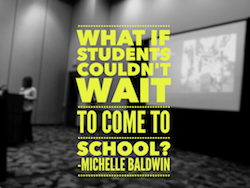Low stress image activities
 Are you looking for a media-making activity that’s not a ridiculous technical challenge for college students? If you want students to concentrate on crafting a visual message and not spend a lot of time learning a new tool, then try asking them to add text to an image. Sounds pretty simple, right? Tony Vincent of Learning in Hand calls this kind of graphic an “Infopic.” In the video below he does a nice job of explaining how you can incorporate them into a class.
Are you looking for a media-making activity that’s not a ridiculous technical challenge for college students? If you want students to concentrate on crafting a visual message and not spend a lot of time learning a new tool, then try asking them to add text to an image. Sounds pretty simple, right? Tony Vincent of Learning in Hand calls this kind of graphic an “Infopic.” In the video below he does a nice job of explaining how you can incorporate them into a class.
Tony’s blog is all about using mobile devices for learning, and he uses the word iPhoneography to describe the use of a smartphone to capture or manipulate images. Most of your students would probably find it easy to use a mobile device to take a picture (or find an online image) and add text to it, but using PowerPoint on a laptop or desktop may be an easier solution.
Borrowing from or extending ideas in the video, students could (for starters) create images that visualize any of the following:
- Application of a mathematical theorem,
- Pivotal quote from a French film,
- Definition of a biology term,
- Theme of an Elizabethan novel,
- Current trend in economics, or
- Highlight from a marketing video.
This will likely be a low-stakes activity, where grading is as simple as check or no-check. On the other hand, you might want to reward students who show creativity by combining unlike concepts, using a metaphor, providing a surprising response, or incorporating new ideas.
More activities with images and text
Visual meme. These usually start with an iconic photo (like these on ImgFlip) and add bold text in capital letters (typically and using the Impact font). The text is usually twists a quote or situation associated with the image. This becomes a meme when the same image is used over and over and the results are shared.
Motivational poster. This genre was introduced around 1990 by a company called Successories. It consists of an image in a wide black frame with a short title underneath, often with a subtitle. The motivational message is often about becoming a better person or improving business practices. OR you can have some fun and make a de-motivational poster.
At the bottom I’ve included some (not terribly inspired) examples of these two genres, which I made in PowerPoint.
